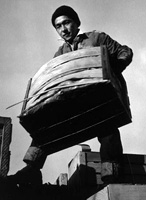Densho: The Japanese American Legacy Project
"Densho" means "to pass on to the next generation." In this quest, this website offers an archive of more than 668 oral histories presented in countless hours of video interviews on Japanese American incarceration during World War II. Materials also include approximately 12,000 historical photographs, documents, and newspapers. Visitors to this website should keep in mind that Densho is continually engaged in expanding its resources and adding more interviews, photographs, and documents, so be sure to check back periodically to discover new content!
Access to archival materials requires free registration. Once registered, users may select materials according to 32 topics, including immigration, community, religion and churches, education, race and racism, identity values, resistance, economic losses, redress and reparations, and reflections on the past.
Materials available without registration include lesson plans and information on "Causes of the Incarceration," "Civil Rights and Japanese American Incarceration," "Sites of Shame: Japanese American Detention Facilities," and "In the Shadow of My Country: A Japanese American Artist Remembers." The website also offers 90 multimedia materials providing historical context, a timeline, a glossary, and a list of related sources in print and online.
